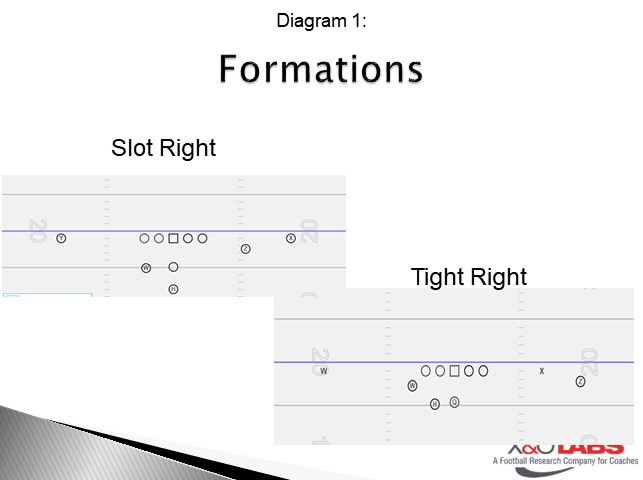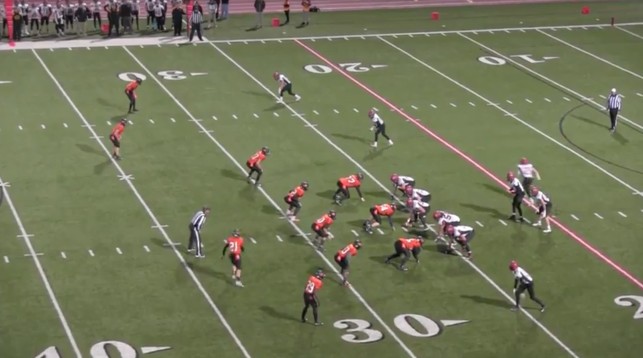By Ken Vigdal
Offensive Coordinator
Brookings High School (SD)
Twitter: @kevigdal
Thanks to the success of University of Arizona offensive coordinator Noel Mazzone and his Nzone system, the “key” screen has taken various shapes and forms the last few football seasons.
What used to be a post-snap RPO screen to the number two receiver has transitioned into getting a back out on the perimeter against a slower inside linebacker. Because of odd front structures, the presence of one or two backers walked up on the line of scrimmage eliminated zone option runs. Many of the teams that we play in our conference ran some type of odd front. When our 20 personnel aligned, you would see 1 or 2 backers walked up on the edges making it a 5 front.
Zone option was effective at the start putting defenses in conflict. Then defenses started to slow play with their backside OLB taking the option part away from the play. Zone option still wasn’t the answer we were looking for. We started running motion with the H or W and noticed that OLB would only adjust one or two shuffle steps out. That’s when we decided to start running zone and Key 3 to the back out of the backfield. We like to run Key 3 with either back out of our Slot formation, or the W out of the Tight formation. This allows us to even up with the defense or gain a +1 advantage.

We were a traditional double tight Wing T team for many years. We made the transition to the Spread Offense 4 years ago. In our spread offense when we have 20 personnel in the game, either in the backfield or a wing position. Teams would put 8 or 9 defenders in the box, which made it difficult to run. To combat so many defenders in the box, we would run jet sweep to get to the edge, to limit the number of defenders we had to block. Defenses would buzz their safeties down into the box with the jet motion or linebackers would crash down hard to take the sweep away. We would run jet motion and run our zone, trap, and power, but running the ball was still a struggle. We had to come up with a solution to combat movement by the defense.

RPO Success
The RPO blocking rules are an extension of our jet sweep, receivers are blocking everyone to the inside with backs running hash, number, and sideline. This makes it simple for our receivers, blocking both the sweep and RPOs the same. We design our RPOs to get one of our best athletes with the ball, in space, and let them use their athletic ability to get up field. The goal is a plus 5, when we throw Key 3, it should gain 5 yards for it to be considered a successful RPO. Although we are a no huddle team, we are a very ball controlled team. We are going to use the run game to gain 3 or 4 yards a carry or throw the RPO for 5. We put many drives together this season that were over 10 plays, leaving the other team’s offense on the sideline.
“Key 3” Responsibilities:
- The offensive line will run their inside zone footwork. Coaching point: when the backside tackle sees the key signal from the sideline, it is an automatic Lock for him. Which means he is going to lock onto the backside defensive end. We do this for two reasons. First the QB may decide to throw the free choice route to the backside, or if we run the Key 3 Go, the routes may take longer to develop. Second, if you don’t lock on to the backside DE he will disrupt the throw or sack your QB.
- Y or backside receiver, if the QB likes the match on the backside, he will throw the free choice route. The backside receiver signals the route he is going to run. He signals every play so the defender doesn’t know when the ball will be thrown or when it is a dummy signal. During game planning, we will choose the three routes that we will use for the week. Our basic choice routes are speed out, fade, and slant. The call route by receiver is dependent upon the depth and leverage of the defensive back.
- Z and X receiver will block the same as jet sweep, positioning themselves to get the ball carrier to the outside. They will engage the defensive player working to the outside shoulder, pinning them inside. Coaching point: if the defensive player takes an outside stem, and the receiver cannot pin him in, he will turn and push the defender outside to the sideline. When the running back sees the receiver’s numbers perpendicular to the line of scrimmage, he will cut up the field and work his way back outside if he can.
- W will go in motion, and when he gets a yard inside number two receiver, he will start to carioca. We have done it other ways, but this technique it keeps his shoulders square to the line of scrimmage, allowing him to read his blocks of the receivers. If the W does not go in motion, he will use his inside zone footwork.
- H will go in motion and use the exact same footwork as the W did for Key 3. If not, he will use his inside zone footwork.









